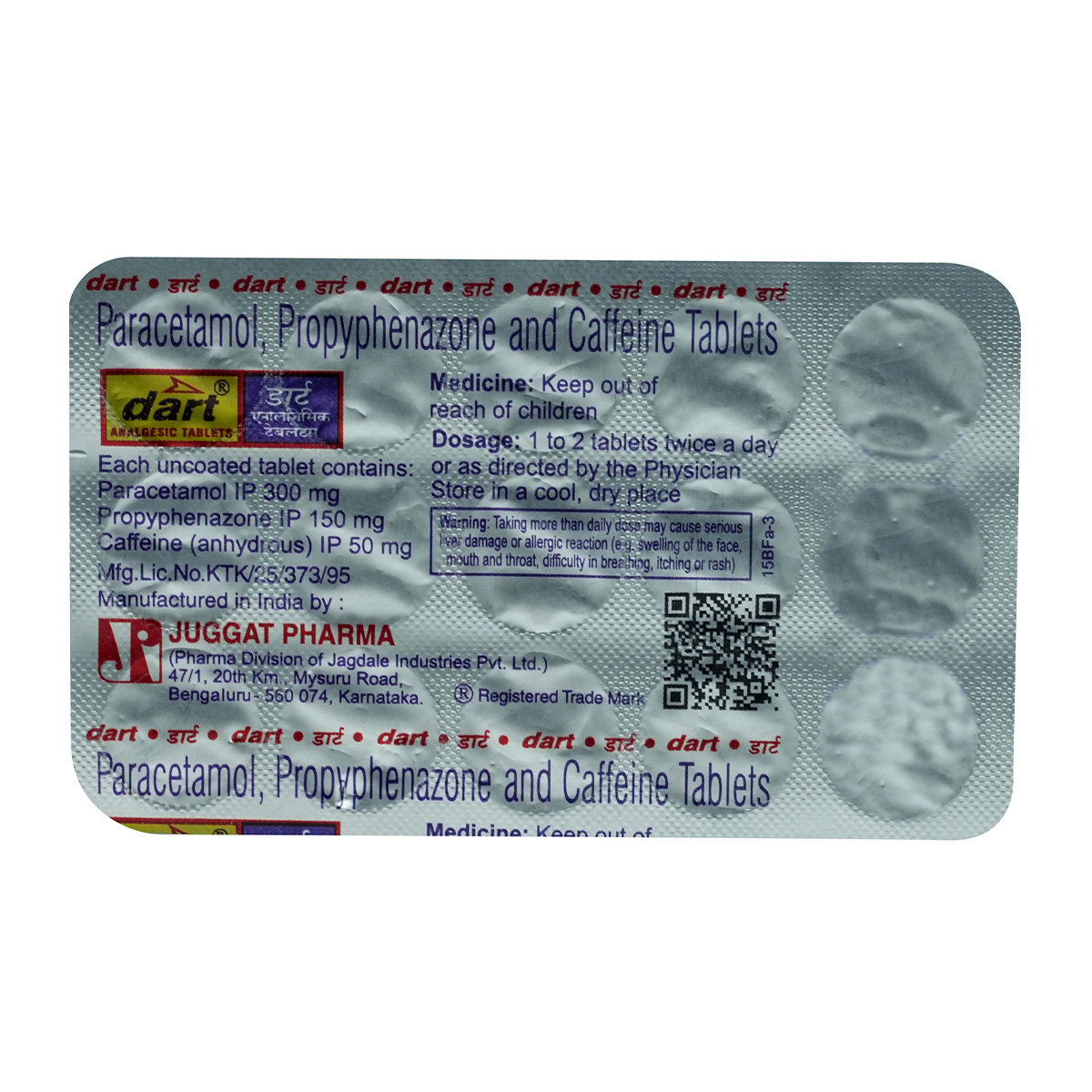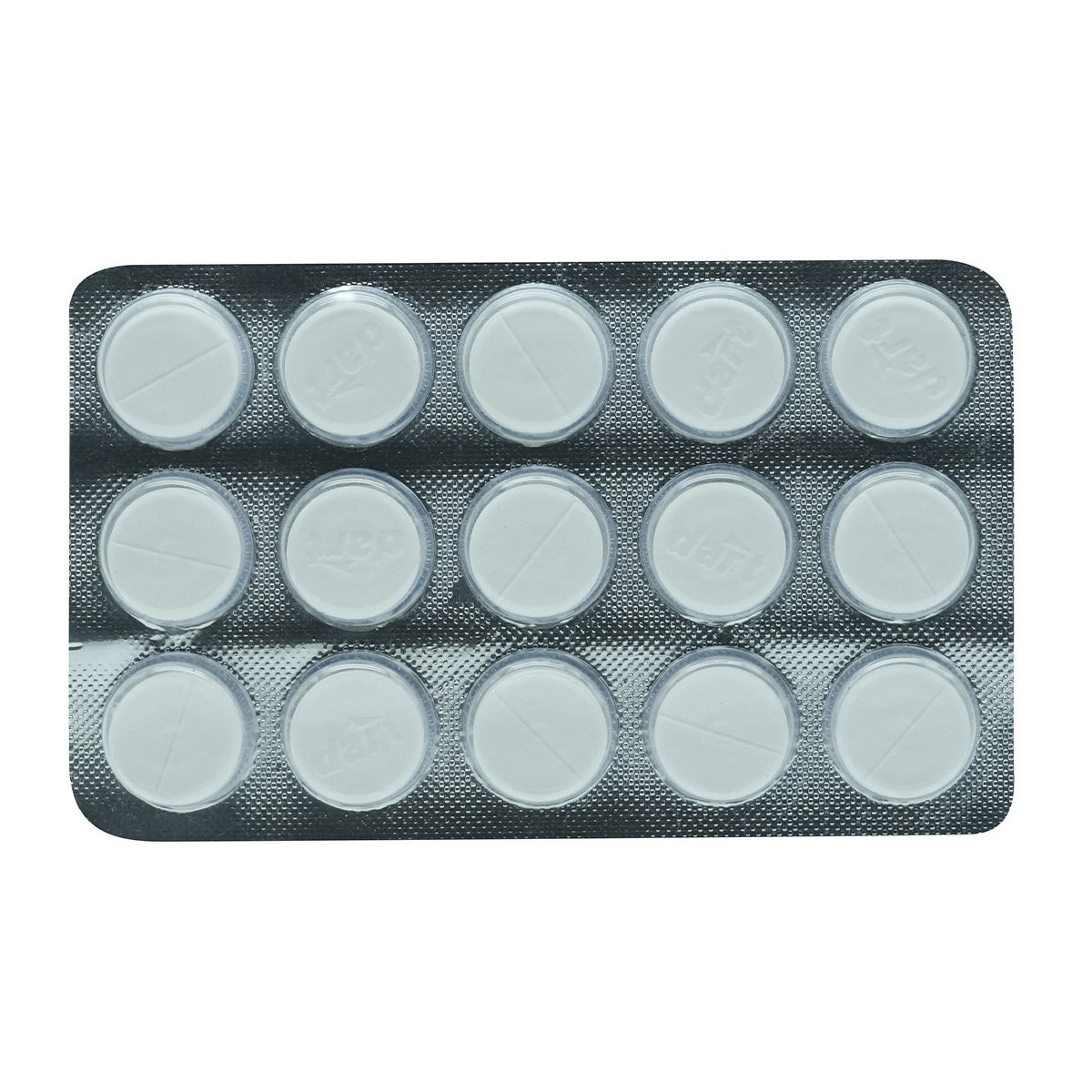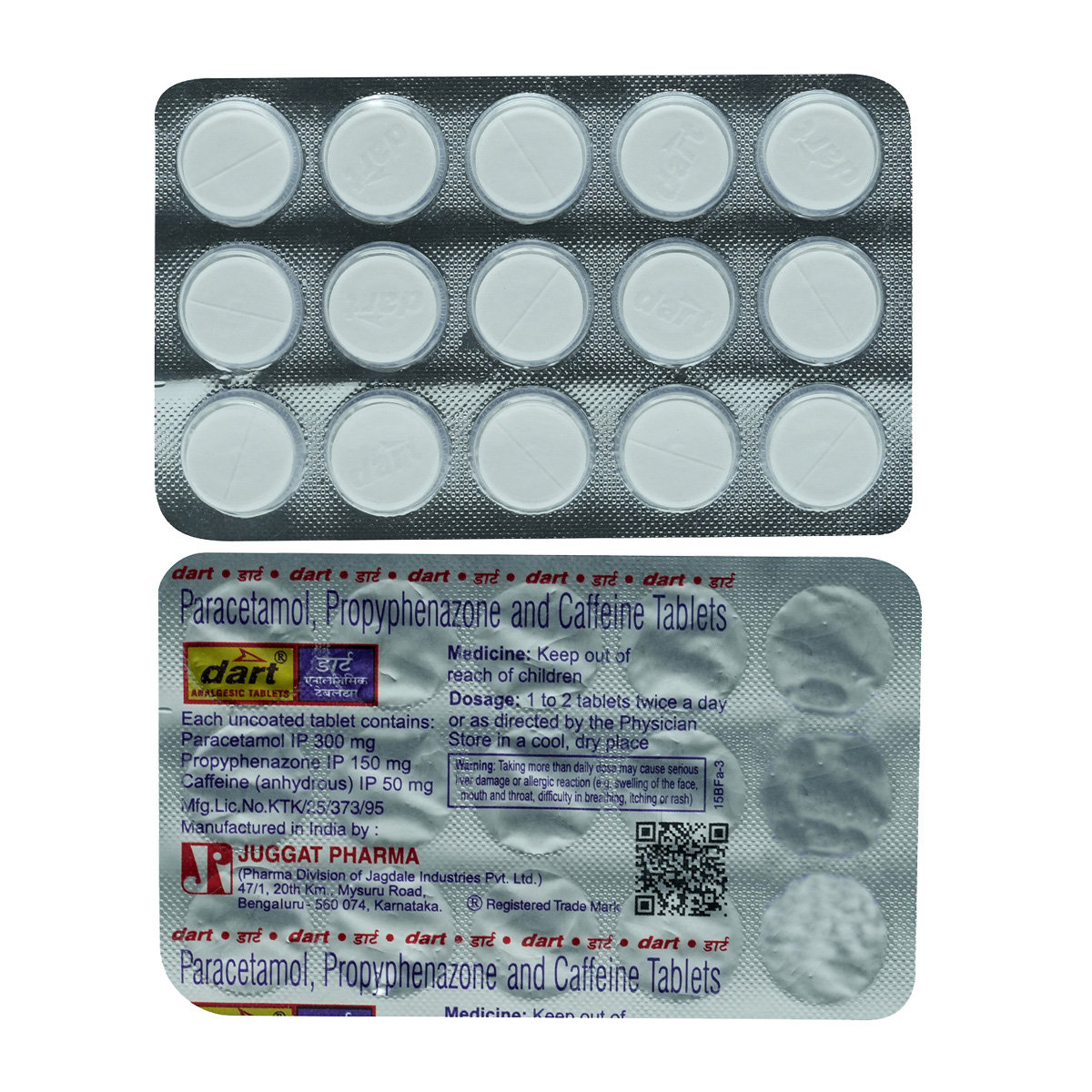Dart Tablet



MRP ₹60.5
(Inclusive of all Taxes)
₹9.1 Cashback (15%)
know your delivery time
Provide Delivery Location
Composition :
Manufacturer/Marketer :
Consume Type :
Expires on or after :
Return Policy :
Selected Pack Size:15
15 ₹54.5
(₹3.63 per unit)
In Stock
10 ₹45.5
(₹4.55 per unit)
In Stock

Secure Payment

Trusted by 8 Crore Indians

Genuine Products
Therapeutic Class
Country of origin
Manufacturer/Marketer address
Disclaimer
Alcohol
Safe if prescribed
Taking Dart Tablet with alcohol may cause dizziness or drowsiness. Besides this, it can also damage your liver if taken for a longer duration. So, avoid or limit intake of alcoholic beverages with Dart Tablet .
Pregnancy
Consult your doctor
Use of Dart Tablet during pregnancy is not recommended as taking this medicine during the last 3 months of pregnancy may harm the unborn baby
Breast Feeding
Consult your doctor
Dart Tablet is known to pass through milk in some amount. So, it should be taken with caution if you are breastfeeding. Take Dart Tablet only if prescribed by your doctor.
Driving
Safe if prescribed
After taking Dart Tablet you may notice dizziness, sleepiness, drowsiness or fatigue as it contains paracetamol which causes sedation. So, in this, you should stop taking Dart Tablet and contact your doctor.
Liver
Consult your doctor
Dart Tablet to be taken with caution, especially if you have a history of liver disease. The dose may have to be adjusted by your doctor.
Kidney
Consult your doctor
Dart Tablet to be taken with caution, especially if you have a history of Kidney diseases/conditions. The dose may have to be adjusted by your doctor.
Children
Safe if prescribed
Dart Tablet is contraindicated in children younger than 12 years of age. It may cause kidney problems in children and adolescents who are dehydrated.
Product Substitutes
About Dart Tablet
Dart Tablet belongs to a class of painkillers called non-steroidal anti-inflammatory drugs (NSAIDs). Pain can be temporary (acute) or long-lasting (chronic) in nature. Acute pain is for a short time caused by damage to the tissues of the muscle, bone, or other organs. While, chronic pain lasts for a long duration and is caused due to pathologies like nerve damage, osteoarthritis etc. Besides this, it is also useful for dental pain which can occur due to damage to the tooth nerve, infection, decay, extraction, or injury.
Dart Tablet is composed of Propyphenazone, Paracetamol, and Caffeine. Together it relieves symptoms of arthritis, and dysmenorrhea (painful periods or menstrual cramps), and reduces fever. Propyphenazone and paracetamol are known to have analgesic and antipyretic effects for reducing mild to moderate pain. They work by lowering the elevated body temperature and mild pain by inhibiting the synthesis of a chemical messenger (prostaglandin) and by promoting heat loss (through sweating) that helps reset the hypothalamic thermostat. Caffeine acts as a common stimulant by narrowing the blood vessels and reducing headaches.
Take it as advised by your healthcare provider. If stomach upset or irritation occurs, it is advisable to take Dart Tablet with food or milk. It should be swallowed whole with a glass of water. Do not crush or chew the tablets. Like all medicines, Dart Tablet may cause side effects, although not everybody gets them. Stop taking this medicine if you experience symptoms like tightness of the chest, breathing difficulties, fever, skin rashes, increased heart rate and or in case of any signs of hypersensitivity.
Do not take Dart Tablet if you are allergic to painkillers like aspirin, paracetamol, naproxen, or diclofenac. It is not recommended for use in children, people with liver disease, heart disease, or gastric ulcers/bleeding problems. Dart Tablet may be associated with a small increase in the risk of heart attack (myocardial infarction). Avoid the consumption of alcohol as it may damage your liver and cause increased side effects from taking the drug. Consult your doctor if your symptoms of pain, inflammation, and fever do not disappear even after ten days.
Uses of Dart Tablet
Medicinal Benefits Mweb
Key Benefits
Dart Tablet is composed of propyphenazone, caffeine and paracetamol primarily used to treat mild to moderate pain. Dart Tablet treats pain and relief from discomfort caused by conditions like tooth pain, arthritis, period pain and another type of short-term pains. It helps in treating pain by blocking the chemical messenger in the brain responsible for causing pain. Propyphenazone and Paracetamol lower the elevated body temperature and mild pain by inhibiting the synthesis of prostaglandin by promoting heat loss (through sweating) that helps reset the hypothalamic thermostat and caffeine helps in reducing drowsiness caused due to paracetamol. Caffeine acts as a common stimulant by narrowing the blood vessels and reducing headaches. Paracetamol has got the advantage of producing less gastric irritation compared to other painkillers like aspirin.
Directions for Use
Side Effects of Dart Tablet
- Nausea
- Indigestion
- Stomach pain
- Restlessness
Drug Warnings
Alcohol intake should be avoided with Dart Tablet as it may lead to unpleasant side effects (dizziness, weakness, drowsiness). It is not recommended for children, severe liver/kidney-related ailments, or pregnant women. Regular monitoring of kidney function may be advised by the doctor in such cases. Elderly patients should exercise extreme caution while using Dart Tablet as the probability of occurrence of side effects in such patients is higher. Caffeine can pass in the breast milk which may have a stimulating effect on the breastfed child. Please seek medical advice if you are pregnant or breastfeeding.
Drug-Drug Interactions
Drug-Drug Interactions
Login/Sign Up
Taking these two together can cause your blood pressure to rise, a condition known as a hypertensive crisis.
How to manage the interaction:
Taking Dart Tablet with Linezolid is not recommended, please consult your doctor before taking it. It can be taken if your doctor prescribes it. Do not stop taking any medication without consulting your doctor.
Taking these two together can cause your blood pressure to rise, a condition known as a hypertensive crisis.
How to manage the interaction:
Taking Dart Tablet with Phenelzine is not recommended, please consult your doctor before taking it. They can be taken if your doctor advises it. Do not stop taking any medication without consulting your doctor.
Coadministration of tranylcypromine with Dart Tablet can in cause severe high blood pressure.
How to manage the interaction:
Taking Dart Tablet with Tranylcypromine is not recommended, but it can be taken together if prescribed by a doctor. However, consult your doctor if you experience headache, confusion, blurred vision, problems with speech or balance, nausea, vomiting, chest pain, convulsions, and sudden numbness or weakness (especially on one side of the body). Do not discontinue any medications without consulting a doctor.
Taking these two together can cause your blood pressure to rise, a condition known as a hypertensive crisis.
How to manage the interaction:
Taking Dart Tablet with Isocarboxazid is not recommended, please consult your doctor before taking it. It can be taken if your doctor prescribes it. Do not stop taking any medication without consulting your doctor.
Co-administration of Dart Tablet may decrease the excretion rate of Oxazepam which could result in a higher serum level.
How to manage the interaction:
Although there is a possible interaction between Oxazepam and Dart Tablet, you can take these medicines together if prescribed by a doctor. Do not stop using any medications without a doctor's advice.
Co-administration of ketamine and Dart Tablet may decrease the effectiveness of Ketamine which could result in a higher blood level.
How to manage the interaction:
Although taking Ketamine and Dart Tablet together can evidently cause an interaction, it can be taken if a doctor has suggested it. If you're feeling very sleepy or having trouble breathing, it's important to contact your doctor right away. Do not stop using any medications without a doctor's advice.
Co-administration of Teriflunomide with Dart Tablet may increase the risk or severity of Liver problems.
How to manage the interaction:
Taking Dart Tablet with Teriflunomide together can possibly result in an interaction, but it can be taken if a doctor has advised it. Do not discontinue any medications without consulting a doctor.
Co-administration of Dart Tablet and Ketoconazole may increase the risk of liver injury.
How to manage the interaction:
Although there is a possible interaction between Dart Tablet and Ketoconazole, you can take these medicines together if prescribed by a doctor. However, if you have joint pain or swelling, fever, chills, unusual bleeding or bruising, skin rash, itching, over-tiredness, nausea, vomiting, loss of appetite, stomach pain, dark-colored urine, light-colored stools, and/or yellowing of the skin or eyes, contact a doctor immediately as these may be signs and symptoms of liver damage. Do not discontinue the medication without consulting a doctor.
Co-administration of Dart Tablet and Leflunomide may increase the risk of liver problems.
How to manage the interaction:
Although there is a possible interaction between Dart Tablet and Leflunomide, they can be taken together if prescribed by a doctor. However, if you experience fever, chills, joint pain or swelling, unusual bleeding or bruising, skin rash, itching, less desire to eat, fatigue, nausea, vomiting, abdominal pain, or yellowing of the skin or eyes, contact a doctor immediately. Do not discontinue any medications without consulting a doctor.
Co-administration of Dart Tablet and Valdecoxib may increase the risk or severity of adverse effects.
How to manage the interaction:
Although there is a possible interaction between Dart Tablet and Valdecoxib, you can take these medicines together if prescribed by a doctor. However, if the side effects worsen, please consult a doctor.
Drug-Food Interactions
Drug-Food Interactions
Login/Sign Up
Drug-Diseases Interactions
Drug-Diseases Interactions
Login/Sign Up
Drug-Drug Interactions Checker List
- METOCLOPRAMIDE
- PHENOBARBITAL
- PHENOBARBITONE
- CARBAMAZEPINE
- RIFAMPICIN
- PRILOCAINE
- SULFINPYRAZONE
Habit Forming
Diet & Lifestyle Advise
- Include more glucosamine, chondroitin sulphate, vitamin D, and calcium-enriched supplements. Besides this, turmeric and fish oils can help in reducing inflammation in the tissue.
- Do not go for heavy exercise as it may increase your headache. Instead, you can do stretching and yoga which will help to feel fresh.
- Your sitting posture is important especially when you have pain and inflammation. Try to sit as little as possible, and only for a short duration of time.
- Long-term immobility is harmful in conditions like arthritis.
- Use back support like a rolled-up towel at the back of your spine curve to minimize pain.
- Keep your knees and hips at a right angle. Besides this, you can also use a footrest if required.
All Substitutes & Brand Comparisons
RX
Dart Tablet 10's
Juggat Pharma Ltd
₹50.5
(₹4.55 per unit)
25% COSTLIER

Have a query?
Buy best C.n.s Drugs products by
Intas Pharmaceuticals Ltd
Sun Pharmaceutical Industries Ltd
Torrent Pharmaceuticals Ltd
Alkem Laboratories Ltd
Abbott India Ltd
Cipla Ltd
Alteus Biogenics Pvt Ltd
Micro Labs Ltd
Lupin Ltd
Ipca Laboratories Ltd
D D Pharmaceuticals Pvt Ltd
Icon Life Sciences
Mankind Pharma Pvt Ltd
Tripada Healthcare Pvt Ltd
Arinna Lifesciences Ltd
Linux Laboratories Pvt Ltd
East West Pharma India Pvt Ltd
La Renon Healthcare Pvt Ltd
Talent India Pvt Ltd
Tas Med India Pvt Ltd
Zydus Healthcare Ltd
Cnx Health Care Pvt Ltd
Eris Life Sciences Ltd
Leeford Healthcare Ltd
Emcure Pharmaceuticals Ltd
Macleods Pharmaceuticals Ltd
Sigmund Promedica
Aristo Pharmaceuticals Pvt Ltd
Dr Reddy's Laboratories Ltd
Troikaa Pharmaceuticals Ltd
Consern Pharma Ltd
Zydus Cadila
Shine Pharmaceuticals Ltd
Wockhardt Ltd
Ardent Life Sciences Pvt Ltd
Crescent Formulations Pvt Ltd
Theo Pharma Pvt Ltd
Reliance Formulation Pvt Ltd
Ikon Pharmaceuticals Pvt Ltd
Propel Healthcare
Neon Laboratories Ltd
Jagsam Pharma
Msn Laboratories Pvt Ltd
Morepen Laboratories Ltd
Pulse Pharmaceuticals
Sanofi India Ltd
Med Manor Organics Pvt Ltd
Hetero Healthcare Pvt Ltd
Novartis India Ltd
Crescent Therapeutics Ltd
Elder Pharmaceuticals Ltd
Solvate Laboratories Pvt Ltd
Akumentis Healthcare Ltd
Mova Pharmaceutical Pvt Ltd
Psyco Remedies Ltd
Tripada Lifecare Pvt Ltd
Ajanta Pharma Ltd
Cyrus Remedies Pvt Ltd
Medishri Healthcare Pvt Ltd
Cadila Healthcare Ltd
Glenmark Pharmaceuticals Ltd
Matteo Health Care Pvt Ltd
Hbc Life Sciences Pvt Ltd
Lyf Healthcare
Matias Healthcare Pvt Ltd
Mesmer Pharmaceuticals
Alembic Pharmaceuticals Ltd
Capital Pharma
Crescent Pharmaceuticals
Medopharm Pvt Ltd
Alniche Life Sciences Pvt Ltd
Kivi Labs Ltd
Talin Remedies Pvt Ltd
USV Pvt Ltd
Quince Lifesciences Pvt Ltd
Solis Pharmaceuticals
Infivis Life Care
Zuventus Healthcare Ltd
Cadila Pharmaceuticals Ltd
Pfizer Ltd
Wallace Pharmaceuticals Pvt Ltd
A N Pharmacia Laboratories Pvt Ltd
Blue Cross Laboratories Pvt Ltd
Jenburkt Pharmaceuticals Ltd
Lia Life Sciences Pvt Ltd
Mano Pharma
Medley Pharmaceuticals Ltd
Primus Remedies Pvt Ltd
FDC Ltd
Maneesh Pharmaceuticals Ltd
Apex Laboratories Pvt Ltd
Gagnant Healthcare Pvt Ltd
Ozone Pharmaceuticals Ltd
RPG Life Sciences Ltd
Strides Shasun Ltd
Unichem International
GlaxoSmithKline Pharmaceuticals Ltd
Kuresys Labs Pvt Ltd
LA Pharma
Trion Pharma India Llp


